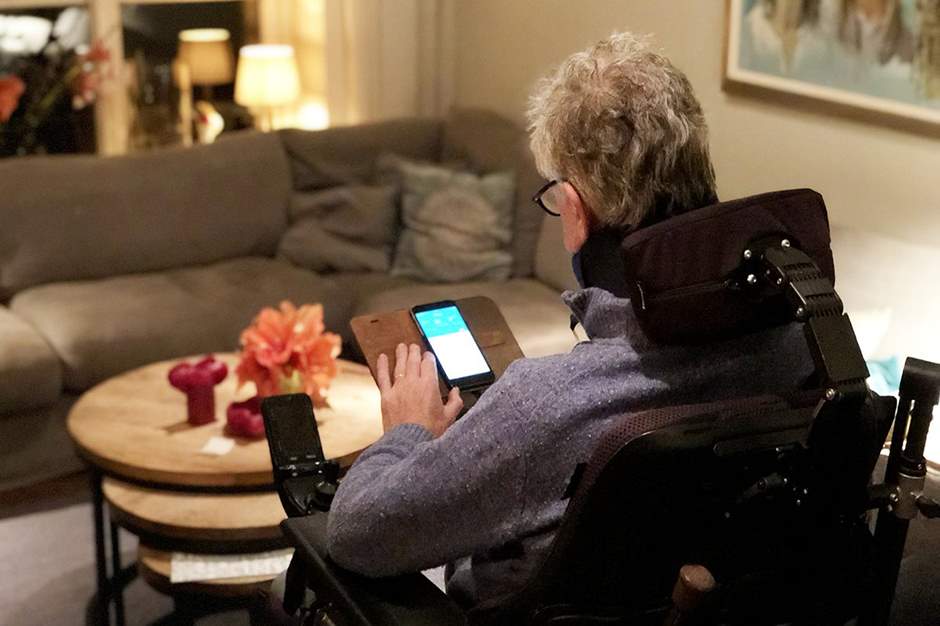Digital healthcare solutions
If care can be provided at home, that is what we do. It gives patients more control over the care that they receive, and the possibility to recover in their own familiar environment. This enables healthcare professionals even better to deliver appropriate care according to the patient’s needs. To deliver the right care in the right place, we cooperate and coordinate with our (chain) partners to develop an innovative digital healthcare offer through data science, artificial intelligence and digital technology. These innovations also help us keep healthcare accessible within the overall cost chain, n view of the growing demand for healthcare and the shrinking labor market. By providing care at home whenever possible, making more beds available for other patients.
In 2022 home monitoring and treatment increased further.
Digital healthcare results
Overall in 2022 we see that home monitoring and treatment increased further. The number of patients included rose with more than 50%. This was partly due to an increase in our remote healthcare services. Home monitoring via Early@Home also contributed at the start of 2022 to the fact that less COVID-19 patients needed to be hospitalized, or that patients could stay in hospital for shorter periods, whereby beds could be freed for other patients. In the podcast Voorzorg in 2022 we shared our vision of digital healthcare - from home monitoring and remote triage to home treatment and ongoing remote monitoring - and the role of our Medical Control Center in delivering human-oriented digital healthcare.
Patients with muscle disease satisfied with digital care
Since 2017 rehabilitation care providers have been monitoring the disease progression of a group of patients with a muscle disease like ALS by means of an online care platform. A study by a doctoral candidate at the UMC Utrecht Brain Center shows that patients find this remote care more pleasant than traditional care, with relatively few on-site appointments. They also feel safer because they have the feeling that their treatment team are continuously keeping an eye on matters.

COVERED: 24/7 remote monitoring of patients
With the growing demand for emergency care and a continued scarcity of healthcare professionals, change is needed to give everyone high-quality acute care in the right place. Halfway through 2022 we started with the project COVERED , where we will eventually be able to monitor patients with (infectious) diseases 24 hours a day, 7 days a week from our Medical Control Center .
To see how we can provide 24/7 optimal and safe home monitoring and for whom, we first monitored about 250 patients of our regular nursing unit in a pilot study. Vital functions like heartbeat, respiratory rate, oxygen saturation, blood pressure, and temperature could be monitored from the Medical Control Center. There is also daily remote contact from the center with patients and the caregiver, because personal attention for the patient remains essential. COVERED makes the home environment a safe place in which to recover (further) from for instance a respiratory infection or surgery. The ministry of Public Health, Welfare and Sport has granted € 650,000 to COVERED.
Specialist pharmaceutical care at home
In 2022 around 1,500 patients, both children and adults, received specialist pharmaceutical care at home from UMC Utrecht. For example chemotherapy for patients with lung cancer, or antibiotics for instance for patients with a chronic lung disorder or an infection following a hip or knee operation. In 2022 our pharmacy delivered 14,000 antibiotic infusions in order to treat patients at home rather than at the hospital. Administering specialist drugs at home contributes to patients’ quality of life. It can also shorten hospital stays or sometimes even prevent hospitalization.
To ensure that patients also receive essential care at home in a way that fits into their everyday life, we have set up an integral process that is centered on the patient. It involves not only the medical treatment team, but also transfer nurses, the (outpatient) pharmacy, and district nurses. And if necessary, the eHealth team and monitoring staff of the Medical Control Center as well. For example with polyneuropathy patients who use the polyneuropathy@home app.
Big data in healthcare for the littlest ones
To help doctors determine with more certainty whether a premature baby suffers from late-onset neonatal sepsis (LOS), we have developed a a decision-support machine-learning model. LOS is a frequent disease babies in the neonatal intensive care unit (NICU) that can be fatal for the baby. The condition is however hard to diagnose, due to varying, unspecific symptoms. Often doctors give antibiotics as a precaution, but the unnecessary administering of antibiotics - in about 60% of all cases - has a negative effect on the baby’s quality of life with a bigger chance of developing resistance to antibiotics. By means of an algorithm it is now for the first time possible to make last-minute patient data such as heartbeat and blood-test results directly available for the machine-learning model. This opens the way to the implementation of more models based on current patient data. The final decision on treatment of course remains with the doctor at all times.
Remote consultation
At UMC Utrecht we offer remote consultation where possible and if that is what the patient wants. In 2022 we did 16,063 video consultations (21,000 in 2021). The number of e-consultations (an email from a patient to a practitioner via My UMC Utrecht) in 2022 was 114,962 (108,483 in 2021).
Patient portal https://www.umcutrecht.nl/en/patient-portal-my-umc-utrecht
Via the online patient portal My UMC Utrecht (https://www.umcutrecht.nl/en/patient-portal-my-umc-utrecht) patients have safe and fast access to their medical information and can have some control over the care that they receive. Via an e-consultation on the portal, a patient can for example ask their doctor a (non-urgent) question or request a repeat prescription. In 2022, 417,884 patients logged in on the portal (unique logins). In 2021 there were 355,000.